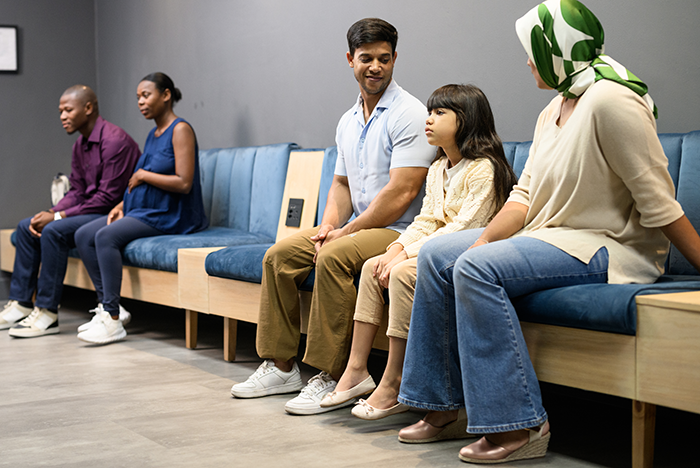Exploring family-friendly design trends

Image from Getty Images
Families are an important part of the health care journey for many patients, yet ensuring hospital spaces support a variety of family activities (beyond the family-zoned patient room) is a potentially overlooked component of design. The Center for Health Design’s Knowledge Repository includes several papers on family-centered care, and three recent ones are featured here.
In a study on the beneficial effects of green space on family caregivers in India, Phatak and colleagues used video recordings to note the impact of sequential design “nudges” on family caregiver use of a balcony garden.
Researchers reoriented waiting room furniture to face garden windows, used floor patterns to direct attention to the garden and strategically placed plants and artwork to nudge family members to use the garden while waiting for loved ones having surgery. They also enhanced the outdoor space with larger plants, a colorful awning and additional chairs, hand sanitizers, waste bins and pedestal fans to improve the usability of the outdoor space. After the phased interventions, not only did more people use the space, but the time spent in the space also increased.
Another research team located in Denmark explored the impact of family-friendly furnishings on the relationship between parents in palliative care and their children.
After interviewing the children, living room-like furnishings (e.g., a sofa, bookcase, cushions and television) and gaming equipment were included in the rooms of their seriously ill parents. Buchwald and colleagues conducted brief interviews with the ill parents. Patients indicated the family-friendly setup normalized visitation. Gaming equipment and the opportunity to watch television together provided distraction from the terminal illness and supported family bonding time. The chance for children to engage in familiar activities while in the patient room was a positive experience for the parent patients. The results of the study demonstrated that a few alterations to the typical hospital room can foster meaningful family relationships.
Papautsky and Abdulbaseer used observations to study the activities of intensive care patients’ family members.
They identified two main types of activities — clinical information exchanges and nonclinical patient care. Information-related activities included receiving or requesting patient status details and participating in care decisions. Nonclinical activities by family members included helping patients with eating, assisting with grooming and entertaining the patient. These findings go beyond the traditional view of patients’ families as primarily emotional support systems and recognizes the complex responsibilities family members assume in communicating with caregivers and participating in formal and informal care processes.
Each of these studies addresses a different aspect of family engagement in patient care. While waiting spaces and family zones are important, there are other considerations that might support family involvement in reducing stress, maintaining relationships and improving participation.
More research on ways to accommodate family activities in health care settings and other health care design topics is available in The Center for Health Design’s Knowledge Repository.
Research used for this column
The following research citations from The Center for Health Design’s Knowledge Repository of health care design resources were used by the author when writing this column:
- S. Phatak et al., “A Choice-Based Design Approach to Influence Beneficial Use of a Green Space by Family Caregivers at a Tertiary Care Hospital in India,” HERD: Health Environments Research & Design Journal, 2023, in press.
- D. Buchwald, D. Buchwald and D. Melgaard, “The Impact of a Family-Friendly Hospital: A Patient Perspective,” HERD: Health Environments Research & Design Journal, 2023, in press.
- E. L. Papautsky and U. Abdulbaseer, “Capturing the Work of Patients’ Family Members in the Medical Intensive Care Unit Using Naturalistic Observations,” HERD: Health Environments Research & Design Journal, 2023, in press.
About this column
“Design Discoveries” highlights research from The Center for Health Design’s Knowledge Repository, a user-friendly library of health care design resources. This research effort is supported by the American Society for Health Care Engineering, the American Institute of Architects, the Academy of Architecture for Health Foundation and the Facility Guidelines Institute.
Yolanda Keys, R.N., NEA-BC, EDAC, research associate, The Center for Health Design.




